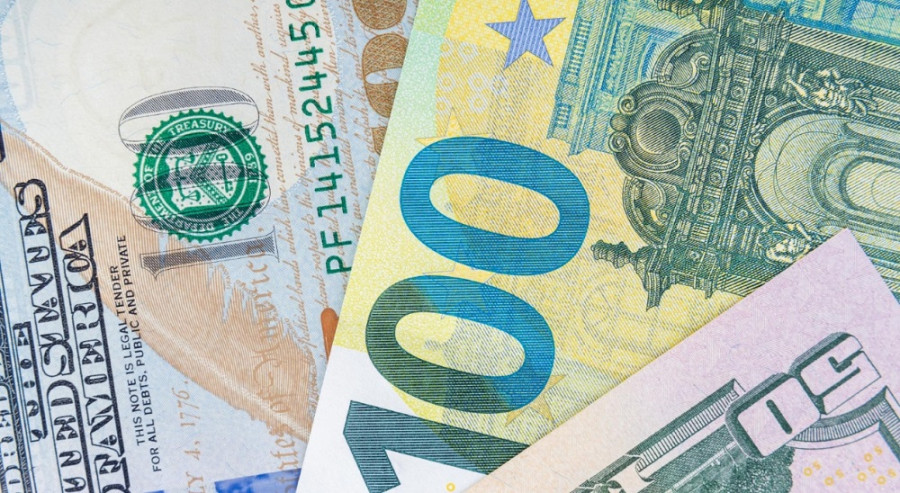
The EUR/USD pair ended the trading week at 1.0645. On the weekly chart, there is another bearish candle, the tenth in a row. Over the past ten weeks, the pair has been within the framework of a pronounced downtrend, amid the greenback's strength and the euro's weakness. The main events of this month are behind us: the European Central Bank and the Federal Reserve announced their verdicts, and key data on inflation were released in Europe and the United States. However, this does not mean that the last week of September will be boring and uninformative. Not at all! For instance, the most important inflation report (the PCE price index) will be published in the United States on Friday, which may provoke strong turbulence for the EUR/USD pair.
Following the results of a 10-week downward movement, the pair was at a crossroads. EUR/USD bears managed to settle within the 6th figure, thanks to hawkish hints from the Fed and the vague position of the ECB, whose rhetoric has become "final". But the prospects for further downward movement are questionable. In ten weeks, the pair has lost 600 points. And judging by the weekly chart, the downward momentum is gradually fading: the bears' weekly gains are reduced to several dozen points. All this suggests that bears need another impetus, and thanks to that the price will test the 5th figure. Otherwise, the bulls will seize the initiative again, sending the pair to the area of the 7th figure with the prospect of returning to the range of 1.0750 - 1.0850.

As mentioned earlier, both the Fed and the ECB have delivered their verdicts over the past two weeks. While the ECB preemptively raised rates, hoping for the cumulative effect of earlier decisions, the Fed maintained its rate unchanged but announced another rate hike at one of the upcoming meetings (either in November or December).
What's interesting is that despite hints from the Fed, traders are quite skeptical about the prospects of a November rate hike. The probability of a quarter point hike being realized is estimated at only 26% (according to the CME FedWatch Tool). The probability of a rate hike in December is slightly higher, at almost 40%. This is because Fed Chair Jerome Powell effectively tied the fate of the rate (at least in the context of the November meeting) to the dynamics of inflation in the United States. It's worth noting that U.S. inflation has started to accelerate again amid rising oil prices, while core inflation indexes continue to show a downtrend. Therefore, each subsequent inflation report will be evaluated in light of the Fed's potential reaction.
This is precisely why the core PCE index is important. It is closely monitored by members of the Fed. We will learn the August value of the indicator on Friday, September 29th. According to preliminary forecasts, year-over-year, the core PCE price index is expected to decrease to 3.9% (the lowest level since September 2021). Recall that in June, it dropped to 4.1% from the previous reading of 4.6%, and then in July, it slightly increased to 4.2%. If the PCE falls below the 4% mark in August, the dollar will come under pressure. However, if the indicator remains in the "green zone," the bears will have a reason to pull down the pair.
On the same day, the eurozone will release its inflation report for August. Here, too, a fairly sharp decline in the indicators is expected. For instance, year-over-year, the Consumer Price Index is expected to decrease to 4.5% (the lowest since November 2021), down from the previous reading of 5.2%. The core CPI, excluding energy and food prices, is expected to reach 4.8% (the lowest since October 2022), after rising to 5.3% in July. If these indicators come in at least at the forecasted levels, let alone in the "red zone," the euro will come under significant pressure, as the likelihood of another ECB rate hike in 2023 will drop to zero.
Therefore, considering the results of the Fed and the ECB's September meetings, traders will focus on the inflation data. They have the potential to trigger price turbulence in the pair.
Of course, the economic calendar for the upcoming week is filled with other events as well. For example, on Monday, Germany will release the IFO indices for September, and ECB President Christine Lagarde will present a report to the European Parliament. On Tuesday, the U.S. Consumer Confidence Index and new home sales figures will be announced. There will also be speeches by Fed representatives Neel Kashkari and Michelle Bowman. On Wednesday, investors will focus on U.S. crude oil inventory data (given recent developments in the oil market, this report could have an impact on EUR/USD). On Thursday, traders can look to German inflation for August and the final estimate of the U.S. GDP report in the second quarter. Finally, on Friday, in addition to European inflation and the core PCE index, labor market data for Germany will be published.
However, all the aforementioned reports will remain in the shadow of the two inflation reports, which will determine the fate of the EUR/USD pair in the medium term. In case of an unexpected increase in the core PCE index, it has the potential to significantly strengthen hawkish sentiment regarding the Fed's future course of actions. European inflation, on the other hand, has the potential to exert more pressure on the euro if the CPI ends up in the "red zone," especially the core index. Therefore, investors will focus on inflation, and all other reports will play a secondary (supporting) role.